
|
| The author uses a hammer stone to chip rock. |
The hammer stone has been identified by archeologists
as the first tool. Made by Homo Habalis, a forerunner to Homo Sapiens, and dates about two million years ago. This first hammer
was held in the hand and has basically three functions for which it is suited: pounding, grinding and cutting. A relatively
high specific weight and hardness give it much more impact power than a similarly sized piece of timber would have. This hardness
is also what restricts its use as a hammer, because it splinters easily.
The stone was either chipped or ground into the desired shape depending on the
kind of stone: Fine sandstone, limestone and the like were ground serving as grinding stones and the like, while flint was
generally chipped and used for cutting. Some materials like granite could only be worked with spherical hammer stones
made of diorite, a stone of even greater hardness. Thanks to their roundness and composition these hammer stones rarely splintered.
Applied with measured force they were used to slowly pulverize and shape the work piece.

|
| A stone hammer head with groove fashioned to attach to handle. |
It was over a million years before a handle was adapted
to this hand held stone to make a compound tool. Very rarely was a hole made in the stone hammer head for assembling as this
was a rigorous chore. Imagine using a reed drill with sand abrasive to grind away at the stone to produce a hole. It was much
easier to make a hole in the wood handle and wedge the stone into it. Of course early man discovered other materials suitable
for hammers as antler and bone was adapted for simple hammers where making a hole could be produced with arrow like drills
spun between the hands.
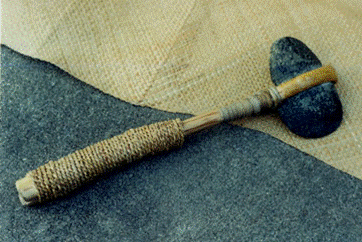
|
| Above is a grooved hammer stone. A typical example of a handle lashed to the stone. |
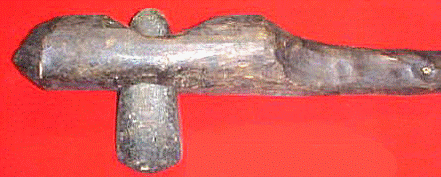
|
| Fig. 4 |
There were various techniques to attaching the hammer
head to a handle, but with the advent of metal casting around 4000 BC a hole was supplied in the hammer head allowing for
a wood handle. Iron could not be completely melted in antiquity as the necessary temperature of more than 1500°C
could not be achieved. The porous mass of brittle iron, which was the result of the smelting in the charcoal furnaces, had
to be worked by hammering in order to remove the impurities. Carburizing and quenching turned the soft wrought iron hammer
head into harder steel. Iron implements are generally less well preserved than those made of copper or bronze. But the range
of these early hammers covers most of today's craftsman's activities.
When early colonists came to this country from their
homelands they brought their tools with them, the hammer included. But hand wrought
iron nails were difficult to make in quantity, and expensive when bought.

|
| A Commander. |
Thus, there just wasn’t much of a demand for
the typical claw hammer. Wood was plentiful and as a result woodworkers used wood joints and easily made wooden pegs called
trunnels for assembly. Wooden hammers ranging in size from the small hand held mallet to the large commander which was used
to nudge together barn beams were dominant. A metal hammer would increase the chance of splitting the piece into which the
wooden peg was driven and have a tendency to mushroom the pegs soft heads. Of
course metal hammers were still used by the blacksmiths and other metalworking craftsmen.
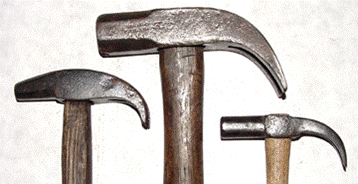
|
| Early hammers without the adz eye were similar to earlier Roman hammers. |
It is well recognized that the claw hammer as we know it today was first used during the Roman times.
This is well documented by artifacts found in museums.
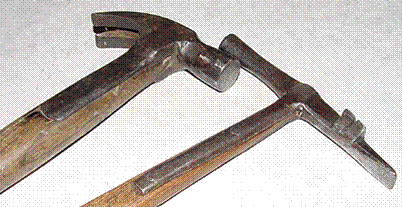
|
| Fig. 7 |
I am sure it had the same problem then as hammers
of the early nineteenth century had, the head flying off the handle or the handle breaking. This problem was the source of
inventive craftsmen developing solutions.
One of the earliest solutions was using metal straps
or flanges that attach to the wood handle for reinforcement. These could be part of the hammer head (Fig. 7) or separate flanges
(Fig. 8) that go thru the hammer head with the handle. They often were riveted to the wood handle just a bit down from the
hammer head.
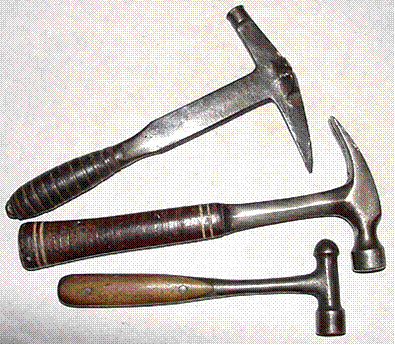
|
| Fig. 9 |
But the holes going thru the handle at this location
weakened the handle and often caused it to break at the rivet hole. Attaching a new handle was difficult using this metal
reinforcement.
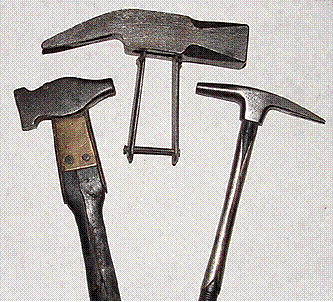
|
| Fig. 8 |
Another technique of stopping the handle from coming
apart from the hammer head is to make it all one piece. Different manufactures were very successful with this design such
as the Perfect Handle hammer and the Estwing hammer. (Fig. 9)
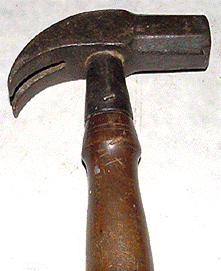
|
| Fig. 10 |
A hammer I recently found seems to borrow a technique
used by early axes. It is a socketed hammer head with the handle firmly driven and riveted into the socket. (Fig. 10)
The first patented hammer in the United States to
approach this problem was by Solomon Anderson from South New Berlin, New York, with his wrap around claw. (Fig. 11)

|
| Figure 11. |
He states that this curved claw attached to a ring
around the handle will prevent the handle from breaking or loosening. Not many examples of this hammer are found today and
when they are seen in tool auctions they usually sell for around $1000.
The most successful hammer modification of modern
times is the adze eye hammer head invented by David Maydole. He was a blacksmith in Norwich N.Y. who made and fixed many different
types of tools. He adapted the eye from the adze which has a wider opening at the top of the head and narrows as it extends
thru the head. By also extending the head further down the handle he produced a hammer head that was stronger and would not
become loose. (Fig. 13).
He never patented this invention but used it in his
very successful hammer manufacturing business which he started in 1845. The business was continued by his family after his
death in 1892. At that time it was the largest hammer manufacturer in the country with 115 employees.
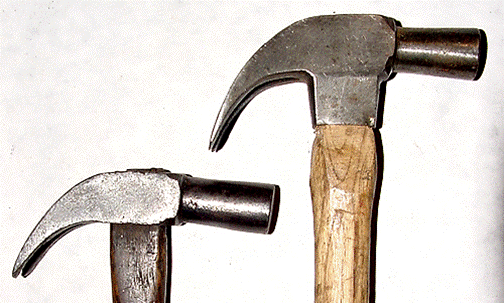
|
| Fig. 13 |
In 1942 the company received its largest order when
the Navy purchased 100,000 hammers for use by their shipyards. A fire destroyed the Maydole factories in 1957 and the business
never recovered. Many Maydole adze eye hammers can be found today, but finding a non– adze eye Maydole claw hammer is
rare.
As one of the two main functions of the claw
hammer is to extract nails, there have been many patents
designed to complete this endeavor. Some make practical sense while others were over designed and doomed to the rare or never
seen category.

|
| Fig. 14 |

|
| Fig. 15 |
Some patents add small secondary claws on the ends
of the main claws. Patent No. 83,897 filed Nov. 10, 1868 by William Zimmerman was one of the first to do so. (Fig. 14) Edwin
Duryea in his 1893 patent has a small auxiliary claw under the primary large claw. (Fig. 15)
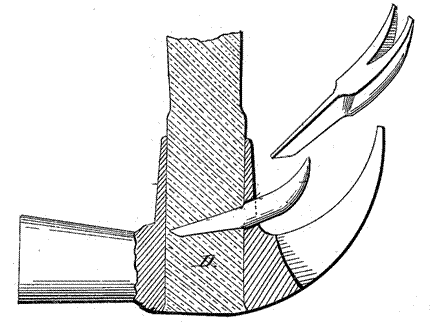
|
| Fig. 16 |
Charles Blydenburgh in 1896 patented a separate supplemental
claw that slides into a recess in the head behind the main claw. (Fig. 16) Of course not all secondary claws are under the
main claw. J.T. Hall in 1916 patented a small starting claw on top of the hammer head and facing the same way as the main
claw (Fig. 17)
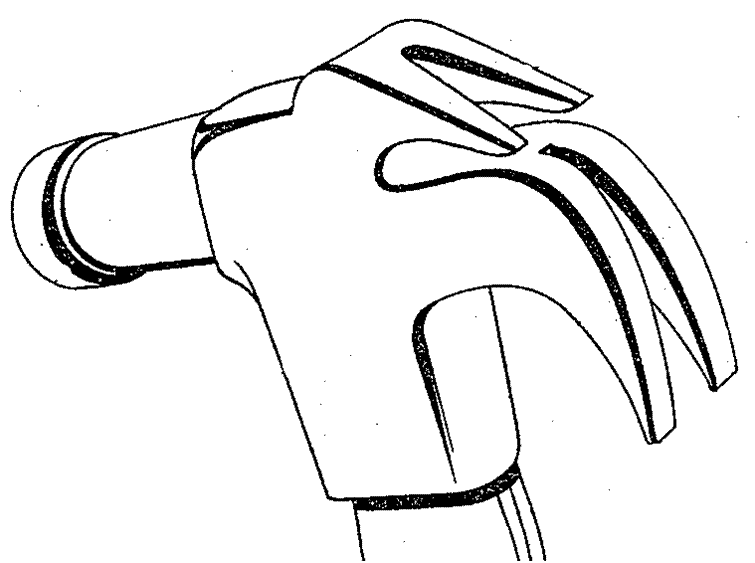
|
| Fig. 17 |
He said this was to minimize strain on the hammer
handle when starting extraction. Two months later W.F. Charley patented a similar starting claw design but turned the claw
around to face the opposite direction of the main claw. (Fig. 18)
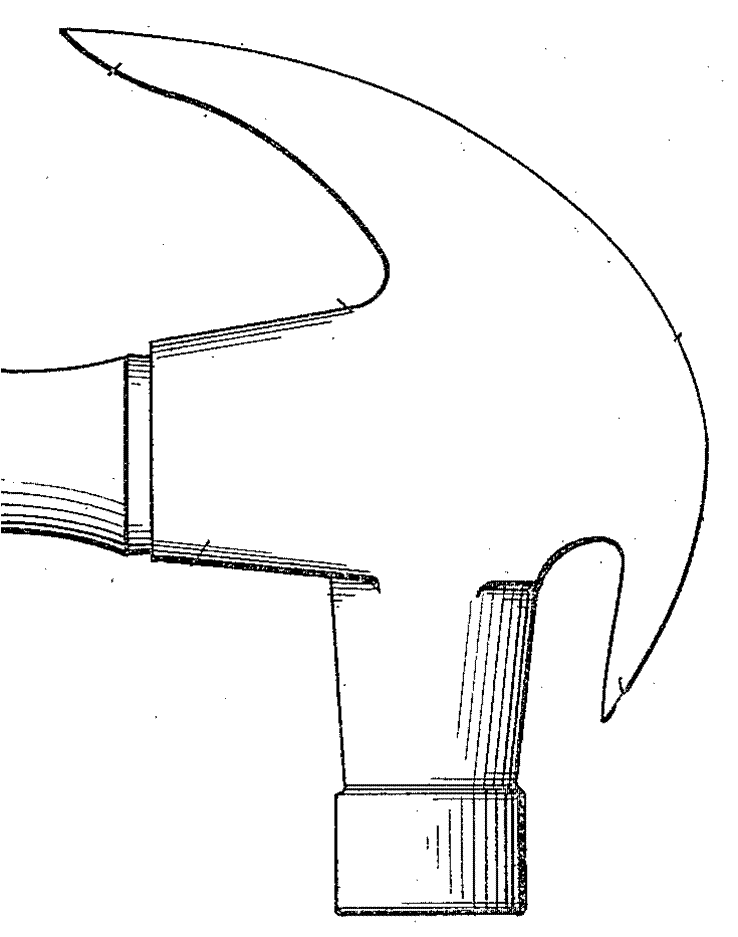
|
| Fig. 18 |
A hammer that attracts many collectors is the two-claw hammer. There is much discussion about where the first
two claw hammer originated. It is often said that the Shaker craftsman forged the first double claw. The one that most collectors
often see is one patented by George F. Voight In 1902. (Fig. 19)
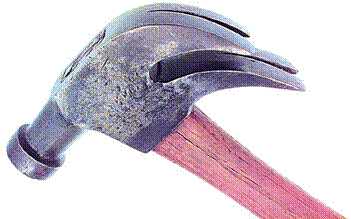
|
| Fig. 19 |
This hammer was made by the Double Claw Hammer Co.
of Brooklyn, N.Y and has the patent date stamped on the side of its head.
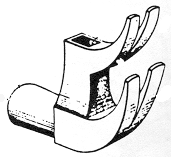
|
| Fig. 20 |
Before this in May 1899 W.W. Brownell of Lake Placid N.Y. patented a similar
double claw for the same purpose of gaining more leverage. (Fig. 20)
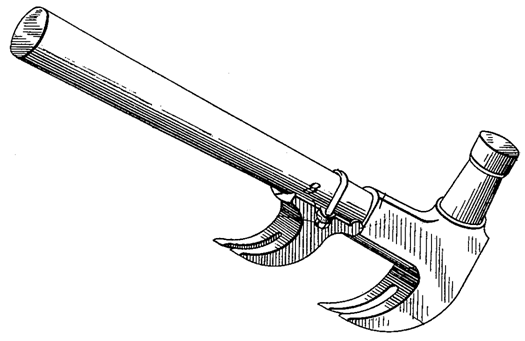
|
| Fig. 21 |
An interesting double claw is another one patented
to W.W. Brownell in 1903. It is an auxiliary claw that attaches to the handle of any regular claw hammer for pulling out long
nails without bending them. (Fig. 21)
Of course if you have a double claw hammer, inventors
have to go one better and invent a triple claw hammer. A triple claw hammer was patented in 1901 by C.I. Yonge. (Fig. 22)
Another triple claw hammer is patented to Hachig A. Ayvad of Hoboken N.J. in 1930. His hammer is similar to the Cheney adze
hammer but has two small claws on the side of the adze claw with a nail pulling in the middle. (Fig. 23)
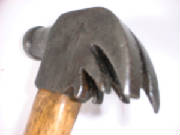
|
| Fig. 22 |
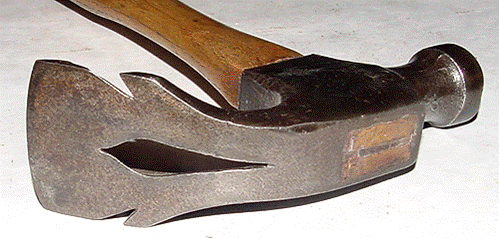
|
| Fig. 23 |
Hachig said this hammer was unique because it could
get at nails in a corner that regular claw hammers could not. Not to be outdone J.N. Jarrell in 1941 patented a four claw
hammer. It has three step-up claws leading up to the main claw. Thus large nails can be pulled out in stages. Of course not all hammers used claws to extract nails. W.A. Day in 1911 patented a toothed eccentric cam
on the side of the hammer head to trap and pull the nail out. Others used the classic pinchers used on the old large slide
pullers. The Hammer George Capewell designed in 1896 is one of the more collectible of these hammers.
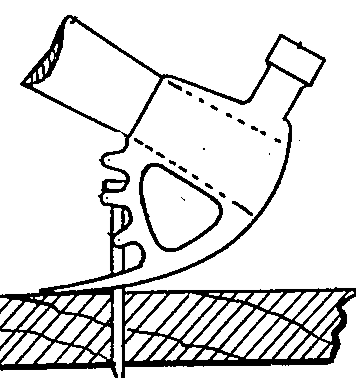
|
| Fig. 24 |
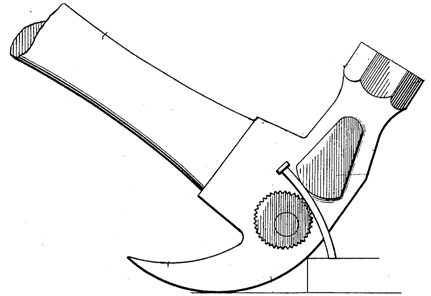
|
| Days cam lock hammer. |
There are many other designs inventors came up with
for extracting nails and finding anything other than a simple single claw is always a treat. Another area
of creative inventions for the claw hammer is starting the nail. Some have become classics such as the 1871 patented Cheney
ball-bearing system fit into the claws of his hammers. Holding nails with different attaching mechanisms under or with the
claws are numerous. While others have a slot on the side of the hammer to hold the nail head. Josiah Clark was the first to
patent this idea with a metallic plate attached to the side of his hammer head with a slot and spring holding the nail head.
Robertson’s Bill-posters hammer uses something similar to this type of attachment to hold his nails for reaching up
out of reach.

|
| Capewells combo hammer. |

|
| Cheney nail holding hammer. |
In 1862 George Mills and Jackson Hanscom from Boston
perfected this design by making a tapered socket intergal as part of the hammer head. In 1860 Charles Carlisle patented a
nail holding device by using a angular lever to hold the nail in place just under the hammer head. Many inventors patented
various mechanisms to hold the nail either under the hammer head or just above it.
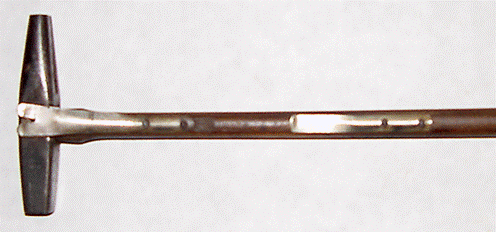
|
| Robertsons Bill posters hammer. |
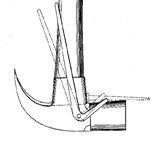
|
| Carlisle lever hammer. |
In 1866 W.G. Ward patented an attachment to fit under
the hammer head. It was a small metallic block or (spring socket) that could be bolted on and acted as a seat to hold the
nail. In his patent drawing he included a one-armed man using his patented hammer attachment. Of course necessity being the mother of invention this one armed person probably came up with many cleaver inventions. Lastly, in 1871 Gottlieb Young modified the hammer head to allow for a nail to
sit on top of the hammer head. It is secured in place by a sheet metal spring holder.
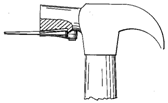
|
| Wards hammer. |
As the Age of Invention found many inventors trying
to invent the better mousetrap, combining different tools into one was the way to riches. One of the highly sought after combination
hammers is the Thayer patent combo hammer. Patented in 1862, John Thayer of Boston claimed that his compound tool in its compactness
offers a graduated scale on the handle bar, a screwdriver, two different claws and of course a moveable hammer head to adjust
leverage.

|
| Youngs hammer. |
Many inventors thought to combine the hammer with
the wrench. A.W. Park of Norwich, Connecticut was the first in 1860 to combine the claw hammer with the monkey wrench and
screwdriver. Byron Boardman’s patent of 1866 improved on this design by installing a cam jaw insert to grip curved objects better.
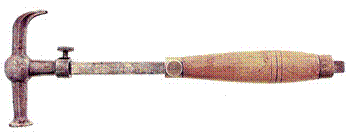
|
| Thayers combo hammer. |
Many inventors combined pliers with hammers but the standard is the cobblers pliers with the dominant
hammer head. Other combination hammers had insertable tools such as screwdrivers, chisels corkscrews, and drills, stored in
the handle.
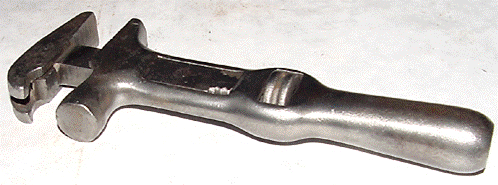
|
| Hammer wrench having both patent dates for Parks and Boardmans patents. |
A cleaver invention was patented by Allen Lake
an employee of the L.S. Starrett Tool Co. He put a magnifying glass in the center of the hammer head to help machinists punch
center marks in fine layouts. Finding one of these hammers stuffed in a drawer of an old machinists tool chest is a rewarding
find.
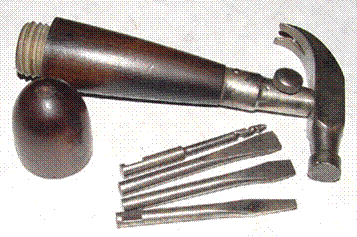
|
| Combo hammer with tools. |
Of course how can one talk of collectible hammers
without mentioning the rare beauties of the sport. Two of the earliest hammers I collected were cigar box hammers with their
fancy relief work and ebony wood handle. Their graceful design and diminutive size intrigued me. I also hunted for the 1901
patented Charles Hennig decorated hammer. With its finely ornamental relief work and nickel-plating it was sure to stand out
in my collection.
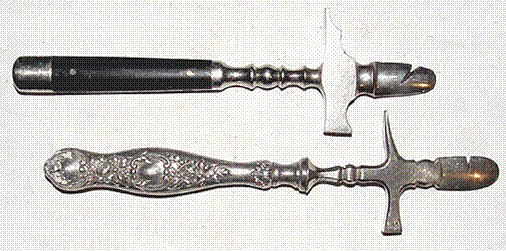
|
| Early cigar box hammers. |
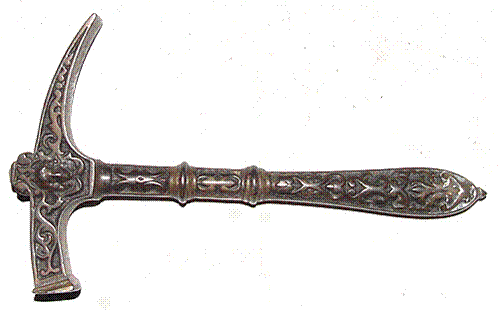
|
| Hennigs decorative hammer. |
Next on my hit list of ornamental hammers was the
1928 patented bronze goats head hammer, designed by toolmaker Mitteldorfer Straus of New York City. Of course if one is talking
about beauty, lets not leave out the ornately lathe turned gavels and carvers mallets of exotic wood.
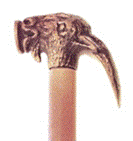
|
| Strauss bronze goat head hammer. |
These finely turned hammers
show not only the skills of the craftsman but also the beauty inherent in the woods used.
Even with all the advancements in hammers
over the years they are still being redesigned. Manufacturers are redesigning for ergonomics making a more comfortable and
user friendly hammer. Carpenters who swing a hammer all day develop elbow problems due to the vibrations emitting from hammering.
The new “Anti-Vibe hammer by Stanley has a tuning fork in the handle to deaden the vibrations.
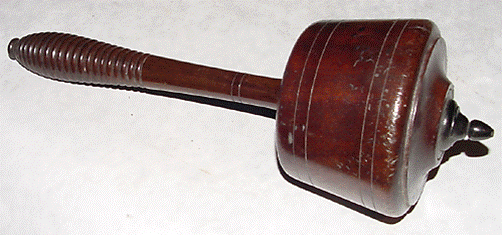
|
| Beautifully turned rosewood mallet. |
Estwing manufacturers has designed a revolutionary new hammer design with
their “Weight Forward” creation. Estwing states that this design “puts the power and weight up front for
easier, more efficient nailing. It has a smooth, continuous face to claw radius for easier nail pulling, a shock-reduction
gasket and comfort grip reducing shock, and the world's strongest fiberglass handle.” It takes a bit getting used to
but is very comfortable.
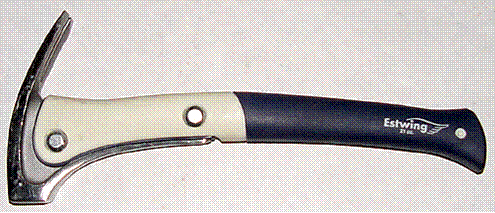
|
| Estwing weight forward hammer. |
Collecting hammers is a very rewarding aspect of tool collecting. It is often
one overlooked by the flea market seller. It is not uncommon to come upon rare finds like a French cobbler’s hammer or a coopers
hoop driver hammer. It is
a very simple task to fix a broken handle with a correct replacement or wire wheel a rusty head. There is a very good market for
blacksmith hammers and farriers hammers for the modern day user who knows
a good old tool. A Heller or Atha blacksmith hammer will be a cherished addition
to any hammer rack.
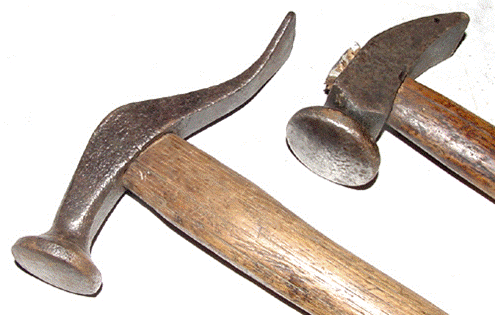
|
| Cobblers hammers. |
Often a stone workers hammer is the prize of an early morning of flea marketing.
These older hammers are still used today by sculptors and demand a good price. Sometimes you will find something that is really odd and lacks any known purpose. This will keep you on edge until you can learn
its function. There are so many more hammers to talk about as the designs
are as rich as their history.
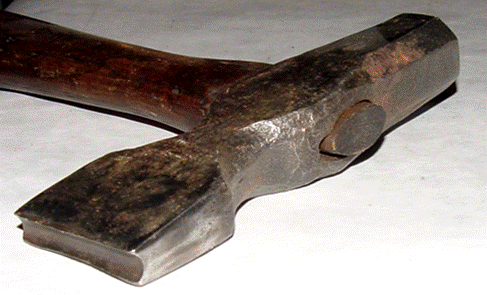
|
| Coopers hoop driver hammer. |
I hope you will send in a picture of any rare finds you have discovered
and let me add it to this article so all our readers can learn more about this fascinating area of tool collecting.
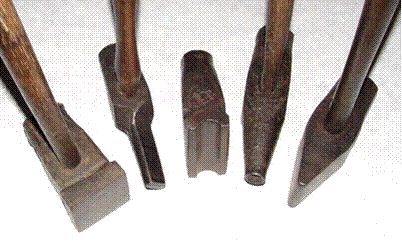
|
| Various blacksmith hammers. |
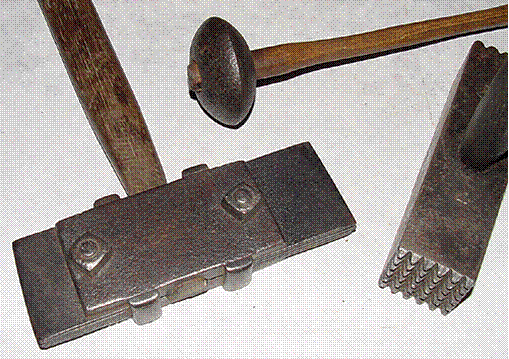
|
| Various stone workers hammers. |
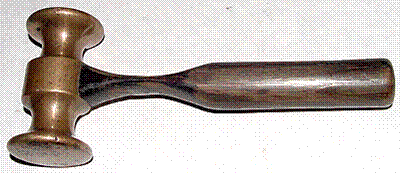
|
| Bronze double headed hammer with slender neck of handle. Use is unknown. |
|



